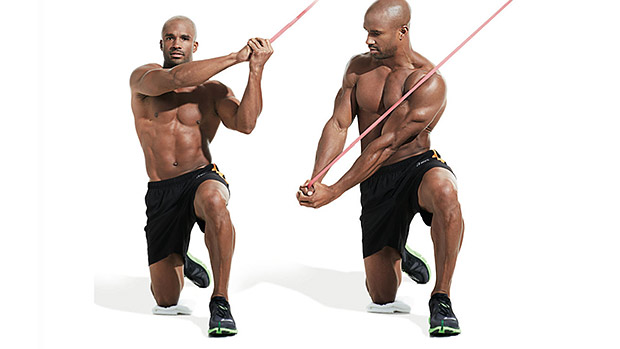Cross-body strength exercises use movements that involve single-arm loading or offset loading, like using two unevenly-loaded dumbbells, which either create rotation or force you to resist rotation from various stances.
The anatomical characteristics of the human body cause it to function in a crisscross manner. The arm-and-shoulder mechanism on one side links diagonally through the torso mechanism to the hip-and-leg mechanism on the opposite side. Think about what you're doing while walking, running, punching, throwing, and batting. Such cross-body linkages are foundational to human functioning and a big part of athletic movement.
So your week of strength training should include at least one the following:
A cross-body pushing exercise, such as a one-arm push-up, single-arm cable press, angled barbell (landmine) press or rotational shoulder press.
A rotational core exercise, such as weight-plate chops, low-to-high cable chops, or high-to-low cable chops.
Although traditional compound exercises – barbell squat, barbell bench press, etc. – can help strengthen the entire body, they're not ideally suited for improving the same type of force generation and neuromuscular coordination patterns of cross-body actions.
This reality is highlighted in research comparing the single-arm standing cable press, which is a cross-body exercise, versus the traditional bench press (1). The study found that performance in the single-arm standing cable press is limited not by maximal muscle activation of the chest and shoulder muscles, but by the activation and neuromuscular coordination of the torso muscles.
In other words, the limiting factor when pushing an offset load with a single arm from a standing position – the position and manner from which field, court, and combat athletes commonly push during competition – is the stiffness of the torso muscles that maintain body position and enable coordination of the hips and shoulders while stabilizing the forces created by the extremities (arms and legs).
In short, different load placement and body position during an exercise changes the force generation and neuromuscular coordination demands of the exercise. Cross-body exercises involve a different type load placement and body position than compound exercises.
- Santana JC et al. A kinetic and electromyographic comparison of the standing cable press and bench press. J Strength Cond Res. 2007 Nov;21(4):1271-7. PubMed.





